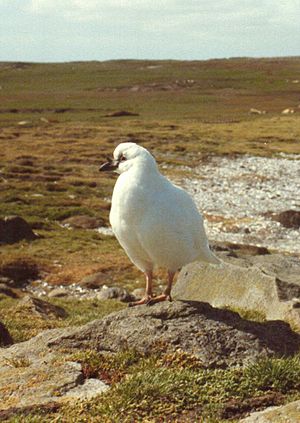Black-faced sheathbill facts for kids
Quick facts for kids Black-faced sheathbill |
|
|---|---|
 |
|
| Conservation status | |
| Scientific classification | |
| Genus: |
Chionis
|
| Species: |
minor
|
The black-faced sheathbill (Chionis minor) is also known as the lesser sheathbill or paddy bird. It is one of only two types of sheathbills. These birds are a bit like shorebirds. However, they live on land and are scavengers. They mostly eat leftover food on sub-Antarctic islands.
Contents
What Does It Look Like?
These birds are plump and have short necks. They look a bit like pigeons. Their feathers are white. Their bills, the skin on their faces, and their caruncles (fleshy growths) are black.
A black-faced sheathbill is about 38–41 cm (15–16 in) long. Its wings can spread 74–79 cm (29–31 in) wide. They weigh between 460–730 g (1.01–1.61 lb). Male birds are usually a little bigger than females.
Where Do They Live?
Black-faced sheathbills live only on certain islands. These islands are in the southern Indian Ocean. You can find them in:
- The Prince Edward Islands (South Africa)
- The Crozet Islands (France)
- The Kerguelen Islands (France)
- Heard Island (Australia)
There are different groups of these birds. One group, C. m. nasicornis, lives only on Heard Island. Another group, C. m. marionesis, lives only on the Prince Edward Islands.
Their Home (Habitat)
These birds like to live along the coastlines. They also live in the areas between the tides on sub-Antarctic islands. They are often found near large groups of seabirds and seals. They also like to be near places where humans live.
What Do They Eat?
Sheathbills are omnivores, which means they eat both plants and animals. They are also predators and scavengers. This means they hunt some food and also eat what others leave behind.
They eat many different things, such as:
- Stuff washed up on the beach
- algae and other plants
- Small invertebrates (like insects)
- fish
- Eggs and chicks of seabirds
- Seal milk, blood, and placentas (afterbirth)
- Dead animals (carrion)
- Animal waste
- Rodents (like mice)
- Human trash
Their Voice
Black-faced sheathbills make loud, high-pitched calls. Their calls are strong and sound like short, sharp bursts.
Reproduction and Life Cycle
These birds build their nests in cracks, caves, or under large rocks. They make messy piles of plants and other bits they find. These bits often come from seabird and seal colonies nearby.
A female usually lays 2 or 3 eggs. The eggs are creamy-white with brown spots or speckles. The eggs hatch after about 30 days. The young chicks are born partly developed and stay in the nest. They can fly about 50 days after hatching. They start having their own chicks when they are 3 to 5 years old.
Conservation Status
Black-faced sheathbills can be at risk from eating toxic wastes. They are also in danger from animals brought to the islands by humans, like wild cats. However, these birds live in many different places. There is no sign that their total number is going down a lot. Because of this, their conservation status is "Least Concern". This means they are not currently in great danger.
See also
 In Spanish: Picovaina de las Kerguelen para niños
In Spanish: Picovaina de las Kerguelen para niños




